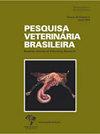巴西东北部牛硝酸盐和亚硝酸盐中毒的临床和毒理学研究结果
IF 0.8
4区 农林科学
Q3 VETERINARY SCIENCES
引用次数: 1
摘要
摘要:我们报告了巴西东北部Paraíba发生的两起硝酸盐和亚硝酸盐中毒事件。第一次是由于象草(Pennisetum purpureum),第二次是由于P. purpureum和Brachiaria spp. (Brachiaria grass),两者都发生在长期干旱期间。在第一次暴发中,用废水和污水灌溉牧场导致硝酸盐积累。第二次暴发发生在大坝边缘的牧场,这些牧场长期被淹没,土壤中积累了大量的有机质。其他可能导致硝酸盐积累的危险因素包括化肥和除草剂的使用以及植被的焚烧。在第一次暴发中,总共42头牛中有4头小牛死亡,在第二次暴发中,243头牛中有49头死亡,包括成年牛、一岁牛和一头2天大的小牛。临床症状包括呼吸困难、发绀、共济失调和跌倒,最终导致死亡。使用二苯胺试验在两次暴发中都检测到硝酸盐的存在。在第二次暴发中使用便携式硝酸盐计进行了定量检测,发现硝酸盐浓度很高。特征性的宏观表现、微观病变的缺失以及对亚甲基蓝治疗的反应是诊断硝酸盐和亚硝酸盐中毒的关键。我们的结论是,在巴西东北部的半干旱地区,由于在长期被水覆盖的水坝边界或废水和/或污水灌溉的地区种植牧草,反刍动物的硝酸盐和亚硝酸盐中毒是经常发生的。此外,使用便携式测量装置是牧场硝酸盐定量的有效替代方法。本文章由计算机程序翻译,如有差异,请以英文原文为准。
Clinical and toxicological findings in nitrate and nitrite poisoning in cattle in Northeastern Brazil
ABSTRACT: We report two outbreaks of nitrate and nitrite poisoning in Paraíba, Northeast Brazil. The first, due to Pennisetum purpureum (elephant grass), and the second, due to P. purpureum and Brachiaria spp. (brachiaria grass), both occurred during a prolonged drought. In the first outbreak, the irrigation of the pastures with wastewater and sewage contributed to nitrate accumulation. The second outbreak occurred in pastures cultivated in the border of a dam, that had been submerged for long time accumulating large amounts of organic matter in the soil. Other probably risk factors for nitrate accumulation included the use of chemical fertilizers and herbicides and burning of the vegetation. In the first outbreak, four calves out of a total of 42 cattle died, and in the second outbreak 49 out of 243 cattle, including adults, yearlings, and a 2-day-old calf died. The clinical signs included dyspnea, cyanosis, ataxia, and falls, leading to death. The presence of nitrates was detected in both outbreaks using the diphenylamine test. Quantitative tests were performed in the second outbreak using a portable nitrate meter, and high nitrate concentrations were found. The characteristic macroscopic findings and absence of microscopic lesions and response to treatment with methylene blue were key to the diagnosis of poisoning by nitrates and nitrites. We conclude that poisoning by nitrates and nitrites in ruminants in the semiarid region of Northeastern Brazil is frequent due to the cultivation of grasses in the border of dams that had been covered by water for long periods or in areas irrigated by wastewater and/or sewage. In addition, the use of a portable measuring device is an effective alternative for the quantification of nitrates in pastures.
求助全文
通过发布文献求助,成功后即可免费获取论文全文。
去求助
来源期刊

Pesquisa Veterinaria Brasileira
农林科学-兽医学
CiteScore
1.30
自引率
16.70%
发文量
41
审稿时长
9-18 weeks
期刊介绍:
Pesquisa Veterinária Brasileira - Brazilian Journal of Veterinary Research (http://www.pvb.com.br), edited by the Brazilian College of Animal Pathology in partnership with the Brazilian Agricultural Research Organization (Embrapa) and in collaboration with other veterinary scientific associations, publishes original papers on animal diseases and related subjects. Critical review articles should be written in support of original investigation. The editors assume that papers submitted are not being considered for publication in other journals and do not contain material which has already been published. Submitted papers are peer reviewed.
The abbreviated title of Pesquisa Veterinária Brasileira is Pesqui. Vet. Bras.
 求助内容:
求助内容: 应助结果提醒方式:
应助结果提醒方式:


